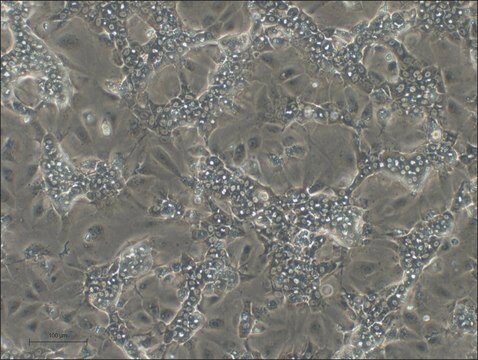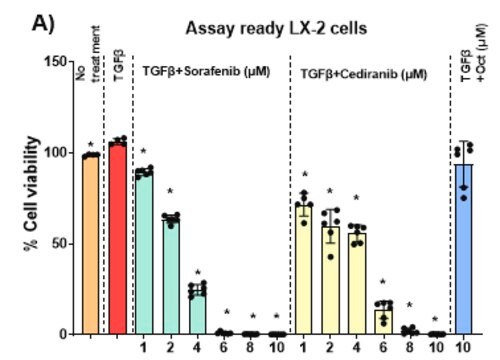SCC613
LX-2 Cas9 Human Hepatic Stellate Cell Line
Synonym(s):
HSC Cas9;Perisinusoidal cells Cas9;Ito cells Cas9;Hepatic pericytes Cas9;Hepatic stellate cells Cas9
Sign Into View Organizational & Contract Pricing
All Photos(4)
About This Item
UNSPSC Code:
41106514
NACRES:
NA.81
Recommended Products
biological source
human
Quality Level
packaging
vial of ≥1X10⁶ cells/vial vial
manufacturer/tradename
Millipore
growth mode
N/A
technique(s)
cell culture | mammalian: suitable
shipped in
liquid nitrogen
storage temp.
−196°C
Application
- Each vial contains >1X106 viable cells.
- Cells are tested negative for infectious diseases by a Human Essential CLEAR Panel by Charles River Animal Diagnostic Services.
- Cells are verified to be of human origin and negative for interspecies contamination from mouse, rat, Chinese hamster, Golden Syrian hamster, and nonhuman primate (NHP) as assessed by a Contamination Clear panel by Charles River Animal Diagnostic Services
- Cells are negative for mycoplasma contamination.
Hepatic stellate cells are a cell type responsible for liver fibrosis following their activation to fibrogenic myofibroblast-like cells in diseases such as chronic alcoholism, hepatitis B and C, fatty liver disease, obesity and diabetes. Given the importance of stellate cells in disease etiology, genetically malleable cellular models are critical for understanding the contribution of these cells to liver pathologies and necessary for development of new therapeutics.
The immortalized LX-2 line was established by Xu et al to overcome issues of culture variability and to provide a stable and unlimited source of human hepatic stellate cells that are homogeneous. These cell lines have been extensively characterized and retain key features of cytokine signaling, neuronal gene expression, retinoid metabolism, and fibrogenesis, making them highly suitable for culture based studies of human hepatic fibrosis.
Source
LX-2 Cas9 human hepatic stellate cells were derived from LX-2 cells transformed with a Cas9 cassette.
LX-2 was generated by immortalization of primary human hepatic stellate cells with the SV40 large T antigen followed by selective culture of early passage cells in low serum media conditions.
References
1.Gut 2005, 54(1): 142-151.
2.PloS One 2013, 8(10): e75692.
The immortalized LX-2 line was established by Xu et al to overcome issues of culture variability and to provide a stable and unlimited source of human hepatic stellate cells that are homogeneous. These cell lines have been extensively characterized and retain key features of cytokine signaling, neuronal gene expression, retinoid metabolism, and fibrogenesis, making them highly suitable for culture based studies of human hepatic fibrosis.
Source
LX-2 Cas9 human hepatic stellate cells were derived from LX-2 cells transformed with a Cas9 cassette.
LX-2 was generated by immortalization of primary human hepatic stellate cells with the SV40 large T antigen followed by selective culture of early passage cells in low serum media conditions.
References
1.Gut 2005, 54(1): 142-151.
2.PloS One 2013, 8(10): e75692.
Features and Benefits
The LX-2 Cas9 human hepatic stellate cell line has been extensively characterized and retains key features of hepatic stellate cytokine signaling, neuronal gene expression, retinoid metabolism, and fibrogenesis , making it a highly suitable model of human hepatic fibrosis.
Storage and Stability
LX-2 Cas9 cells should be stored in liquid nitrogen. The cells can be cultured for at least 10 passages without significantly affecting cell marker expression and functionality. LX-2 cells have been successfully expanded beyond passage 50 in culture.
Other Notes
This product is intended for sale and sold solely to academic institutions for internal academic research use per the terms of the “Academic Use Agreement” as detailed in the product documentation. For information regarding any other use, please contact licensing@emdmillipore.com.
Disclaimer
RESEARCH USE ONLY. This product is regulated in France when intended to be used for scientific purposes, including for import and export activities (Article L 1211-1 paragraph 2 of the Public Health Code). The purchaser (i.e. enduser) is required to obtain an import authorization from the France Ministry of Research referred in the Article L1245-5-1 II. of Public Health Code. By ordering this product, you are confirming that you have obtained the proper import authorization.
Unless otherwise stated in our catalog or other company documentation accompanying the product(s), our products are intended for research use only and are not to be used for any other purpose, which includes but is not limited to, unauthorized commercial uses, in vitro diagnostic uses, ex vivo or in vivo therapeutic uses or any type of consumption or application to humans or animals.
Related product
Product No.
Description
Pricing
Storage Class
10 - Combustible liquids
wgk_germany
WGK 2
flash_point_f
Not applicable
flash_point_c
Not applicable
Certificates of Analysis (COA)
Search for Certificates of Analysis (COA) by entering the products Lot/Batch Number. Lot and Batch Numbers can be found on a product’s label following the words ‘Lot’ or ‘Batch’.
Already Own This Product?
Find documentation for the products that you have recently purchased in the Document Library.
Our team of scientists has experience in all areas of research including Life Science, Material Science, Chemical Synthesis, Chromatography, Analytical and many others.
Contact Technical Service







